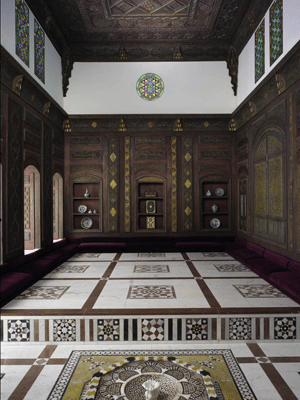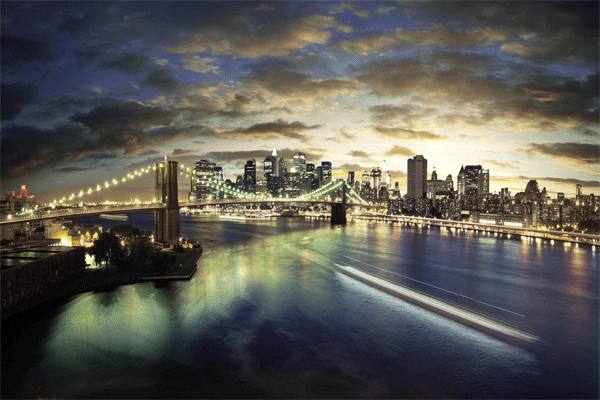The voice is thin but it carries into the busy night,
because there, somewhere, there is someone in prayer.
Muslims travelling beyond their own countries are often
concerned about how they will perform their daily
religious duties. But New York presents no problem as
there are well over half a million Muslims in the city
along with around one hundred fifty mosques.
The Big Apple, as it is nicknamed, is one of the world’s
most most vibrant and visited cities. It consists of
five boroughs – Manhattan, Brooklyn, Queens, The Bronx
and Staten Island. And each one offers many places of
interest. New York has one of the largest populations of
Muslims in the USA. The presence of Muslims dates back
to the late 19th century CE, when Arabs arrived in the
city and settled in Washington Street. Today most
Muslims here are immigrants from the Middle East, Asia
and the Caribbean.
Large communities of Muslims can be found in several
areas especially Midwood, Boerum Hill, Kensington and
Bedford-Stuyvesant in Brooklyn and Harlem and Jackson
Heights in Manhattan. Hundreds of halal restaurants -
including Keur Sokna, Mariachi and Marrakesh - offer
food from just about every country. And there are over
200 street food vendors offering fresh halal favourites.
 The
Islamic Centre of New York is a religious and cultural
organization established in 1960 CE. it comprises a
Mosque, madrissa (school), a library, a lecture hall, a
museum, and a residence for its Imams. It aims to serve
the Muslim community, educate with true knowledge of
Islam and provide rulings of Islamic Law in questions
about religious, social and cultural matters. From time
to time open days are held and the public are welcome.
The
Islamic Centre of New York is a religious and cultural
organization established in 1960 CE. it comprises a
Mosque, madrissa (school), a library, a lecture hall, a
museum, and a residence for its Imams. It aims to serve
the Muslim community, educate with true knowledge of
Islam and provide rulings of Islamic Law in questions
about religious, social and cultural matters. From time
to time open days are held and the public are welcome.
The Statue of Liberty is the main landmark in lower
Manhattan. One of the most prominent buildings in
Midtown is the Empire State. And Times Square is a
must-see as is a play on Broadway. Central Park is huge
and has lush sprawling lawns, cycle and jogging tracks,
restaurants and boating on the lake. It is home to the
Egyptian Obelisk , the pink stone of which was mined
from the quarries at Aswan. The park's ice rink is
popular in winter and Columbus Circle is a landmark to
the southeast.
Greenery abounds in the city, if you know where to look.
New York Botanical Garden, Bronx Zoo, Brooklyn Botanic
Gardens, Queens Botanic Gardens, Coney Island and Staten
Island are great places to visit, especially if you have
children in tow. More flora can be found on the new
landscaped elevated walkway - the HighLine. Here the
black steel columns that once supported abandoned train
tracks now hold up an innovative and inviting public
space – part promenade, part town square, part botanical
garden. It runs from Gansevort in the Meatpacking
District to West 34th Street on Manhattan’s West Side.
Some of the world’s best know museums - The Museum of
Modern Art, the Guggenheim, the Whitney and the
Metropolitan Museum of Art - can be found in the city
and many are located on the Upper East Side in an area
known as Museum Mile. The Met, which was founded in 1870
CE, has recently opened 15 new galleries for Art of the
Arab Lands, Turkey, Iran, Central Asia and later South
Asia.
Reveals Met Director Thomas Campbell, “In sequence the
new galleries trace the course of Islamic civilization
over a span of 113 centuries from the Middle East to
North Africa, Europe and Central and South Asia.”
Highlights include early and medieval Qur’ans, the
Damascus Room and royal miniatures. Furthermore LTMH
Gallery focuses on emerging artists from the Middle
East. And Arte East on Broadway screens films as well as
showcasing fine art from the region.
Indeed the Islamic Centre of New York University
arranges a year-round programme open to the public. A
summer highlight is a Halaqa held in the
 Gardens
of Faith in Battery Park. A halaqa is a religious
gathering or meeting for the primary purpose of learning
about Islam. Halal dining is available at the Kimmel
Centre’s third floor cafeteria between 1200-1500
and1700-2000. Khairat is a programme which aims to
foster interaction and understanding through community
outreach. Every fortnight volunteers gather to work in
children’s hospitals and soup kitchens as well as doing
environmental clean-ups and holding toy drives. The
culmination is NYU Khairat service day attended by some
200 students. Come autumn weekly classes are held.
Subjects include Stories from the Qur’an, Introductory
Arabic, an Introduction to Tajweed, Selected Stories
from the Prophets and an explanation of Nidaa ul
Mu’mineen fil Qur’an al-Mubeen. Tajweed of the Holy
Qur'an is the knowledge and application of the rules of
recitation so the reading of the Qur'an is as the
Prophet Mohammed peace and blesings be upon him,
recited. Separate classes for Tajweed are held for men
and women and there is also a regular Dhikr (Remembrance
of Allah). An Umrah trip (pilgrimage to Mecca) is taken
each year too.
Gardens
of Faith in Battery Park. A halaqa is a religious
gathering or meeting for the primary purpose of learning
about Islam. Halal dining is available at the Kimmel
Centre’s third floor cafeteria between 1200-1500
and1700-2000. Khairat is a programme which aims to
foster interaction and understanding through community
outreach. Every fortnight volunteers gather to work in
children’s hospitals and soup kitchens as well as doing
environmental clean-ups and holding toy drives. The
culmination is NYU Khairat service day attended by some
200 students. Come autumn weekly classes are held.
Subjects include Stories from the Qur’an, Introductory
Arabic, an Introduction to Tajweed, Selected Stories
from the Prophets and an explanation of Nidaa ul
Mu’mineen fil Qur’an al-Mubeen. Tajweed of the Holy
Qur'an is the knowledge and application of the rules of
recitation so the reading of the Qur'an is as the
Prophet Mohammed peace and blesings be upon him,
recited. Separate classes for Tajweed are held for men
and women and there is also a regular Dhikr (Remembrance
of Allah). An Umrah trip (pilgrimage to Mecca) is taken
each year too.
In September a Muslim Day Parade is held along Madison
Avenue. Sponsored by the Muslim Foundation of America,
it takes place on the last Sunday of the month, usually
along 41st Street and Madison Avenue. If you are in
town, don’t miss it. The MFA was formed in 1983 CE with
the aim of promoting a better understanding of Islam
Stateside. Each year the parade grows in size and
significance as merchants and supporting Muslims combine
to celebrate their religion, culture and traditions. New
York is said to be the world’s fashion capital and
houses many malls and shopping districts. Manhattan has
the largest concentration of shops with upmarket
departments stores Bergdorf Goodman, Barneys and
Bloomingdales. In the mid range are Saks and Macys, both
hugely popular. And Madison Avenue between 57th and 86th
Streets is crammed with top designer labels such as
Ralph Lauren, Donna Karan, Prada, Chloe and Gucci The
Malcolm Shabazz market in Harlem is full of fabulous
traditional African crafts and textiles and there are
many halal shops in the area too. New York’s public
transport system is easy to negotiate and inexpensive so
you can have fun exploring by bus or subway. Taxis and
rental cars are good value too. Although these days the
Big Apple is generally a safe destination, it is best to
avoid Williamsburg, Alphabet City, Chelsea and the
Meatpacking District at night.

